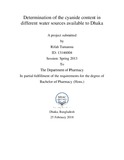| dc.contributor.advisor | Chowdhury, Fabliha Ahmed | |
| dc.contributor.author | Tamanna, Rifah | |
| dc.date.accessioned | 2019-07-17T10:30:59Z | |
| dc.date.available | 2019-07-17T10:30:59Z | |
| dc.date.copyright | 2019 | |
| dc.date.issued | 2018-02 | |
| dc.identifier.other | ID 13146004 | |
| dc.identifier.uri | http://hdl.handle.net/10361/12389 | |
| dc.description | This project report is submitted in partial fulfilment of the requirements for the degree of Bachelor of Pharmacy, 2018. | en_US |
| dc.description | Cataloged from PDF version of project report. | |
| dc.description | Includes bibliographical references (pages 58-60). | |
| dc.description.abstract | Cyanide is known as one of the deadliest chemicals in the world and has a notorious history
including mass genocide. There are very few antidotes against it which only work at a low
concentration of the poison. High exposure to this chemical has no reversal and not only leaves
permanent damage to the body but is also fatal at most of the times. With the growing number of
industries in Dhaka city especially in the plastic, paint and metal sectors which have been known
to release cyanide into the environment, there are higher chances of cyanide pollution now more
than ever. My work focuses on the cyanide concentration in water bodies such as rivers and lakes
which are a dumping ground for chemical wastes and also a comparison of other water available
to the people living in the city. My work includes a survey of the areas that contain water bodies
suspected with cyanide contamination. Samples were taken from these water sources such as the
main water body of the area, tap water supplied into the area and the tube well water pumped from
the ground. Water samples were also collected from non-industrial areas within Dhaka city for a
better comparison. The water samples were then tested for cyanide in the laboratory following
EPA guidelines and quantified. The results were then compared with WHO and US EPA
guidelines for cyanide limit in drinking water. Results were compared with the location and type
of the area within Dhaka city. Results proved cyanide concentration to be within limits but
industrial areas’ to be very close to the borderline and at risk with the rapidly increasing number
of industries every year | en_US |
| dc.description.statementofresponsibility | Rifah Tamanna | |
| dc.format.extent | 60 pages | |
| dc.language.iso | en | en_US |
| dc.publisher | Brac University | en_US |
| dc.rights | Brac University project reports are protected by copyright. They may be viewed from this source for any purpose, but reproduction or distribution in any format is prohibited without written permission. | |
| dc.subject | Cyanide | en_US |
| dc.subject | Water | en_US |
| dc.subject.lcsh | Cyanides--Toxicology | |
| dc.title | Determination of the cyanide content in different water sources available to Dhaka | en_US |
| dc.type | Project report | en_US |
| dc.contributor.department | Department of Pharmacy, Brac University | |
| dc.description.degree | B. Pharmacy | |

